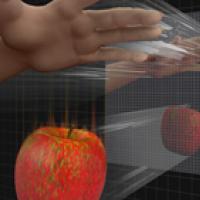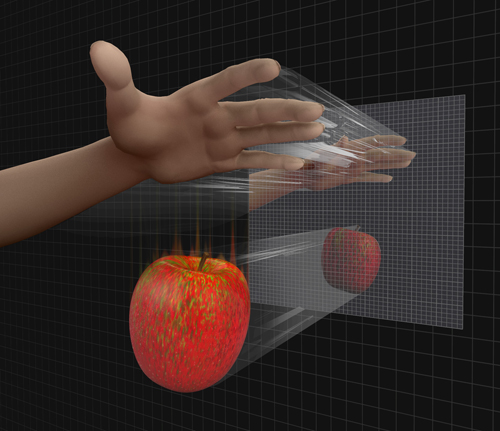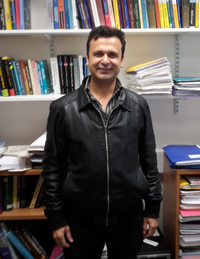
In a lower dimension

This article is part of the Researching the unknown project, a collaboration with researchers from Queen Mary University of London, bringing you the latest research on the forefront of physics. Click here to read more articles from the project.
What if I told you that the world was two-dimensional? In a way that should surprise you more than if I told you it was ten-dimensional. We're all quite happy to accept that the world might be more complicated than our senses suggest — but could it be simpler? It's a possibility that Sanjaye Ramgoolam of Queen Mary University of London, is exploring: he is developing a two-dimensional description of the world. So far the theory only applies to a toy Universe, but his results may one day give us important insights into the real world.
The holographic Universe
Ramgoolam's work lies on the boundary between two theories. The first, called quantum field theory (find out more here), describes the smallest building blocks of nature, sub-atomic particles such as quarks, and their interactions through the strong nuclear force and the electroweak force. Although still a work in progress, quantum field theory has been tested in experiments and done amazingly well. But it has a problem. It cannot describe the third remaining force of nature: gravity. It's one force short of being a theory of everything.

A holographic toy Universe.
The second theory, called string theory (more here), is an attempt to remedy this situation. String theory describes all the fundamental particles and forces using one mathematical framework. It's a beautiful theory that has seduced many with its mathematical elegance, but the trouble is that nobody knows whether it's really true. At the moment there are no experiments one could use to test it, and there won't be for some time. Physicists are therefore caught between a rock and a hard place. Their candidate theory of everything, string theory, is purely speculative and their most comprehensive testable theory, quantum field theory, isn't a theory of everything.
Progress on finding the true theory of everything has been slow, but in 1999 the Argentine physicist Juan Maldacena came up with a truly astonishing way to link string theory and quantum field theory together. Maldacena developed a mathematical toy universe which you can think of, by very loose analogy, as an inflated balloon. The physics on the boundary of the balloon, on its surface, is described by a quantum field theory, which does not contain the force of gravity. The physics in the interior of the balloon is described by a string theory and it does include gravity. What is remarkable is that the two worlds are equivalent: for every process in the boundary, say particles moving together in a liquid, there is a corresponding process in the interior, say the formation of a particular type of black hole. And vice versa. One direction of this two-way correspondence has given Maldacena's discovery its name: it is known as the holographic principle because the boundary physics captures the interior physics as a 2D hologram captures a 3D image.
Neither of the two toy worlds, the one on the boundary of the balloon or the one in its interior, correspond to the real world we live in. The string theory on the inside describes a ten-dimensional world (rather than a 3D one as in our balloon analogy) that is shaped very differently from ours. And the gravity-less boundary world (which is in fact 4D) has many nice features we're not sure the real world actually has. But Madacena's correspondence between the two gives us a way of solving problems we can't solve in string theory using the mathematics of quantum field theory and vice versa. It hints at structures hidden within both theories which may one day give us crucial information about the world we live in. (You can find out more about the holographic principle here).
Holographic physics
Maldacena's correspondence provided a great playground for physicists, and it's in that playground that Ramgoolam and his co-workers have been amusing themselves. Although Maldacena gave the initial impulse, much of the correspondence still needs to be worked out in detail. Gravity is of special interest. Physicists believe that gravity is mediated by a force-carrying particle called the graviton (which hasn't as yet been detected in the lab, so it's hypothetical). The key idea of string theory is that particles aren't like tiny little points moving around in space, but like tiny little vibrating strings, so gravitons take that string shape too. But string theory doesn't stop at strings. Two-dimensional surfaces, like spheres, three-dimensional shapes and higher dimensional objects, all of them sitting within the ten dimensions of the world the theory describes, also play an important role. These are called branes. "A particle is a concentration of matter and energy," explains Ramgoolam. "A brane is a concentration of matter and energy extended over space. It's matter spread out, if you like." Gravitons can also take the form of branes, and when they do, they are called giant gravitons.

Sanjaye Ramgoolam.
The question was what kind of objects giant gravitons correspond to in the boundary world of the holographic correspondence. That boundary world contains no gravity, but it does contain something akin to the strong nuclear force, which holds sub-atomic particles together to form atoms. Just like the electromagnetic force, which works via an electromagnetic field, the strong nuclear-like force works via so-called quantum fields. Ramgoolam considered a special version of quantum field theory which contains several types of these quantum fields. These can combine together to form composites. Some of these composites would correspond to giant gravitons in the interior string theory world. The question was, which ones?
Ramgoolam and his co-workers found explicit answers to this question. In the process they discovered that the composites on the quantum field theory side are best understood using the mathematics of permutations, that is, the maths of rearranging things, which comes with powerful tools. Clever use of them makes the calculations on the quantum field theory side a whole lot easier. Using the correspondence, the calculations could then give answers on the string theory side to questions about gravity that had previously been unsolved. For example, how do low energy gravitons interact with high energy giant gravitons? What are the excitation energies of strings attached to giant gravitons? "We now have a completely new way of calculating gravitational interactions," says Ramgoolam.
The 2D essence
These results are truly fascinating: you can now describe what happens within a 10D world containing gravity via calculations from a 4D world containing no gravity.

Butterfly symmetry
But there is more, so take a deep breath. The 4D quantum field theory world contains a lot of additional symmetry, which you can use to make your set-up even simpler. By very loose analogy, think of a butterfly, which has a symmetry axis down its middle. If you want to understand the pattern on its wings, you only need to consider one of them, as you know the pattern on the other will be an exact mirror image — you only need to consider half the original object. Similarly, using the maths of symmetry to condense out the important pieces of information, Ramgoolam has managed to collapse the 4D quantum field theory into a 2D topological field theory: a world made up of surfaces such as the sphere, or the surface of a doughnut. It's still a work in progress, but the idea is to encode all the information you need to understand the 4D world in 2D surfaces and certain rules on how you can glue them together to form more complicated ones. And since the 4D world describes, via the correspondence, the 10D string theory world, this will mean that the information about the whole 10D world has been repackaged into two dimensions. "It's mind boggling," says Ramgoolam.
What does all of this mean for the real world? Neither of the two worlds linked through Maldacena's correspondence are like the one we live in: they are toy universes, designed to hone our understanding of the theories. "The very fact that gravity [in string theory] can be calculated using [quantum field theory] means that there are hidden structures about the theory that could well be relevant when we come to connect it to the world," says Ramgoolam. "But first we want to understand what those structures are, to understand what the theory really is about." Gravity in string theory still poses a lot of very messy questions. "But what this story tells us is that out of this whole messy thing something very simple emerges, where you can do calculations using very simple combinatorics."
But what if it finally turns out that the real world can be fully described using a 2D topological field theory, just as in Ramgoolam's toy example? What would that mean for the four space-time dimensions we perceive? Presumably it would mean that our senses somehow present us with an overabundance of dimensions. Not that the usual four space-time dimensions are not really there, but that the briefest and most elegant description of the world doesn't need it. Mind boggling indeed!
About this article
Marianne Freiberger, Editor of Plus, interviewed Sanjaye Ramgoolam in London in June 2014.